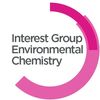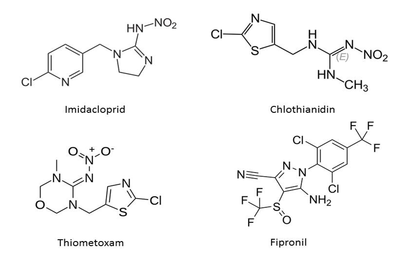How harmful are neonicotinoids to the environment?
ECG Bulletin Editors
ECG Bulletin July 2015
ECG Bulletin July 2015
The World Integrated Assessment of the Impacts of Systemic Pesticides on Biodiversity and Ecosystems (WIA), published on 9 January 2015 (1), provides a synthesis of existing research on the environmental impacts of neonicotinoid pesticides and fipronil, a pesticide with similar properties. Based on over 800 published studies, the report concludes that “the wide-scale use of these persistent, water-soluble chemicals is having widespread, chronic impacts upon global biodiversity.” A recent report by the European Academies Science Advisory Council comes to similar conclusions (2).
Neonicotinoids were first discovered in the 1990s and have since become the most widely used class of insecticides (Figure 1). They are less toxic to vertebrates than to invertebrates and can be applied as seed treatments, soil treatments, and foliar sprays. Neonicotinoids become distributed throughout the plant (they are systemic), making them very effective against sucking pests. They are also used in livestock, aquaculture, and domestic animals. However, studies have shown that many non-target species, particularly bees, are also affected by neonicotinoids. These concerns have led to a partial, two-year ban on the use of neonicotinoids in the EU, starting on 1 December 2013 (3). The recently published European Red List of Bees points to pesticides as one of main threats to bee species, 9.2% of which are classified as at threat of extinction (4). The WIA provides an overview of existing research on the effects of neonicotinoids and another systemic pesticide, fipronil. In this ECG Bulletin article, the term ‘neonicotinoid’ covers both fipronil and the neonicotinoids.
Neonicotinoids were first discovered in the 1990s and have since become the most widely used class of insecticides (Figure 1). They are less toxic to vertebrates than to invertebrates and can be applied as seed treatments, soil treatments, and foliar sprays. Neonicotinoids become distributed throughout the plant (they are systemic), making them very effective against sucking pests. They are also used in livestock, aquaculture, and domestic animals. However, studies have shown that many non-target species, particularly bees, are also affected by neonicotinoids. These concerns have led to a partial, two-year ban on the use of neonicotinoids in the EU, starting on 1 December 2013 (3). The recently published European Red List of Bees points to pesticides as one of main threats to bee species, 9.2% of which are classified as at threat of extinction (4). The WIA provides an overview of existing research on the effects of neonicotinoids and another systemic pesticide, fipronil. In this ECG Bulletin article, the term ‘neonicotinoid’ covers both fipronil and the neonicotinoids.
Such prophylactic use is not compatible with integrated pest management, an approach that has been compulsory for all crops in the EU since 1st January 2014 (6). And thirdly, both the approval process and existing toxicology testing regimes are wholly inadequate for these pesticides, neglecting both their widespread sub-lethal effects on numerous non-target species and synergistic effects resulting from exposure to more than one pesticide or to other additional stressors. For most non-target insect and other invertebrate species that are likely to be exposed to neonicotinoids, “no or very little information is available about the impact of these pesticides on their biology” [reference 1, p. 69]. Furthermore, many effects are highly variable, depending not only on the species but also on the age of the individual, how long it has been exposed, and many other factors.
|
There are cases when neonicotinoids are clearly toxic to non-target species. For example, some bee deaths have been attributed convincingly to neonicotinoid-laden dust after planting. But many other possible effects are more subtle, and observations are difficult to attribute to a specific cause. Pesticide concentrations in pollen or nectar may be on the order of parts per billion, requiring extremely sensitive measurement techniques for detection. Effects may be cumulative over time and may differ between species or, in the case of bees, between different members of the society. Studies have shown that neonicotinoid exposure at levels well below that causing mortality can affect bees’ ability to return to the colony (7); reduce burrowing ability of earthworms (8); and cause paralysis and impaired walking in beetles (9). But it is very difficult to prove these effects at field-realistic conditions (Figure 2). A recent field study (10) makes an important step in this direction by investigating the impact of neonicotinoid exposure on both honey bees and wild bees near oilseed rape fields treated with neonicotinoid. The study is the largest field study so far, involving eight treated fields and eight control fields. In treated fields, the authors found fewer solitary wild bees and a reduced bumblebee colony growth rate.
|
Overall, the body of evidence presented in the assessment gives clear reasons for concern. Hallmann et al. have reported that declines in insect-eating birds in the Netherlands correlate with neonicotinoid use (11), showing the potential cascading effects of these pesticides. It may not be straightforward to implement alternatives, particularly in large-scale agriculture. But continuing to use neonicotinoids at current levels carries the risk of serious environmental damage (12), particularly to non-target species that have important ecosystem functions, such as bees and earthworms, with potentially serious implications for food security.
References
1.WIA, special issue, Environ. Sci. Pollut. Res. 22, Issue 1, pp. 1-154 (2015).
2.Ecosystem services, Agriculture, and Neonicotinoids, EASAC policy report 26, April 2015, available at www.easac.eu.
3.Regulation (EU) No. 485/2013, see http://eur-lex.europa.eu/legal-content/EN/ALL/?uri=CELEX:32013R0485
4.A. Nieto et al., European Red List of Bees (Publication Office of the European Union, Luxembourg, 2014).
5.L. Furlan, D. Kreutzweiser, “Environ. Sci. Pollut. Res. 22, 135-147 (2014).
6.Directive 2009/128/EC, see http://eur-lex.europa.eu/LexUriServ/LexUriServ.do?uri=OJ:L:2009:309:0071:0086:en:PDF.
7.M. Henry et al., Science 336, 348-350 (2012).
8.N. Dittbrenner, I. Moser, R. Triebskorn, Y. Capowiez, Chemosphere 84, 1349-1355 (2011).
9.B. A. Kunkel, D. W. Held, D. A. Potter, J. Econ. Entomol. 94, 60-67 (2001).
10.M. Rundlöf et al., Nature 521, 77-80 (2015).
11.C. A. Hallmann, R. P. B. Foppen, C. A. M. van Turnhout, H. de Kroon, E. Jongejans, Nature 511, 341-343 (2014).
12.F. Sanchez-Bayo, Science 346, 806-807 (2014).
References
1.WIA, special issue, Environ. Sci. Pollut. Res. 22, Issue 1, pp. 1-154 (2015).
2.Ecosystem services, Agriculture, and Neonicotinoids, EASAC policy report 26, April 2015, available at www.easac.eu.
3.Regulation (EU) No. 485/2013, see http://eur-lex.europa.eu/legal-content/EN/ALL/?uri=CELEX:32013R0485
4.A. Nieto et al., European Red List of Bees (Publication Office of the European Union, Luxembourg, 2014).
5.L. Furlan, D. Kreutzweiser, “Environ. Sci. Pollut. Res. 22, 135-147 (2014).
6.Directive 2009/128/EC, see http://eur-lex.europa.eu/LexUriServ/LexUriServ.do?uri=OJ:L:2009:309:0071:0086:en:PDF.
7.M. Henry et al., Science 336, 348-350 (2012).
8.N. Dittbrenner, I. Moser, R. Triebskorn, Y. Capowiez, Chemosphere 84, 1349-1355 (2011).
9.B. A. Kunkel, D. W. Held, D. A. Potter, J. Econ. Entomol. 94, 60-67 (2001).
10.M. Rundlöf et al., Nature 521, 77-80 (2015).
11.C. A. Hallmann, R. P. B. Foppen, C. A. M. van Turnhout, H. de Kroon, E. Jongejans, Nature 511, 341-343 (2014).
12.F. Sanchez-Bayo, Science 346, 806-807 (2014).



